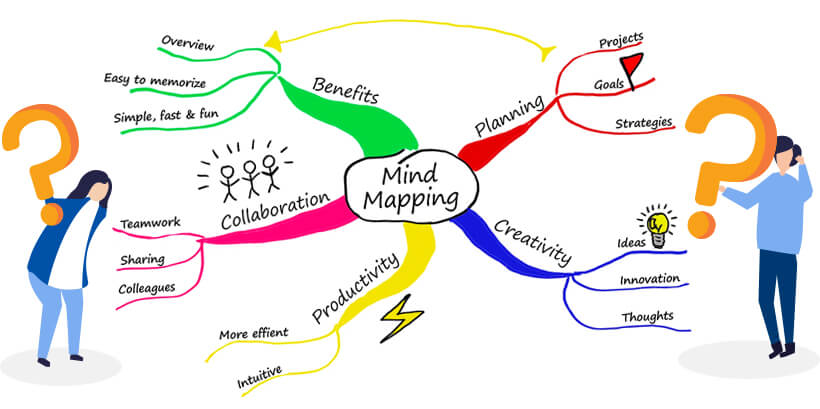Preparing for the Common Law Admission Test (CLAT) can be a daunting task. With an extensive syllabus that covers subjects like legal reasoning, logical thinking, English comprehension, and general knowledge, students often feel overwhelmed by the sheer volume of material they need to grasp. In this situation, adopting a creative and effective study technique can significantly reduce stress and improve retention. One such technique is mind mapping.
Mind mapping is a visual learning tool that allows you to organize and present information in a structured and interconnected manner. By breaking down complex concepts into visual, easy-to-follow diagrams, mind maps help students understand relationships between topics, making the learning process more efficient.
What Is Mind Mapping?
Mind mapping involves creating a diagram that represents words, ideas, tasks, or concepts connected around a central theme. It’s a non-linear way of structuring information, meaning that instead of memorizing long lists or reading blocks of text, you visualize information in an organized flow that shows how everything is connected.
A typical mind map has the following structure:
- Central Idea: The main topic or subject in the center.
- Branches: Key themes or subtopics that radiate out from the central idea.
- Nodes: Details or information linked to the branches.
- Connections: Relationships or links between the branches and nodes.
For CLAT preparation, this technique works wonders for topics that are vast and interconnected, such as Legal Aptitude and General Knowledge.
Why Mind Mapping Is Effective for CLAT Preparation
- Organizes Complex Information
CLAT requires knowledge of diverse subjects that are both theoretical and practical. For instance, in Legal Aptitude, you’ll encounter various legal principles, maxims, and case laws. Instead of trying to memorize them separately, mind maps allow you to connect related concepts, principles, and cases, making them easier to remember and understand. - Enhances Retention and Recall
Research shows that visual representations are processed by the brain faster and retained longer than textual information. Mind maps use color, images, and structure, which engage multiple senses and improve memory retention. By visualizing how concepts interrelate, you can quickly recall information during the exam. - Boosts Creativity and Problem-Solving
Mind maps encourage you to think outside the box by making connections between ideas that may not seem immediately obvious. For CLAT’s Logical Reasoning and Problem-Solving sections, creating mind maps of different types of puzzles or reasoning techniques can help you develop creative approaches to solving problems more efficiently. - Improves Time Management
When studying for CLAT, time is of the essence. Mind maps allow you to review entire topics in a glance, reducing the time spent revisiting long notes or textbooks. They also provide a clear overview of what you’ve covered and what’s left, helping you manage your study schedule effectively. - Tailors to Individual Learning Styles
Whether you are a visual learner, an auditory learner, or prefer hands-on methods, mind maps can be adapted to suit your learning style. You can add color codes, images, and even audio notes to your maps to make learning more personalized and engaging.
How to Use Mind Mapping for CLAT Preparation
Here are some practical ways to incorporate mind mapping into your CLAT study routine:
1. Start with the CLAT Syllabus
The first step in creating a mind map is understanding the scope of the syllabus. Use the official CLAT syllabus as your central idea and branch out the key topics such as:
- English Language
- Current Affairs and General Knowledge
- Legal Reasoning
- Logical Reasoning
- Quantitative Techniques
Each subject can be further broken down into subtopics. For example, in Legal Reasoning, you could create branches for legal maxims, important case laws, and principles of law. This gives you a high-level overview of everything you need to cover.
2. Mind Mapping for Legal Aptitude
Legal Aptitude is one of the most important sections of CLAT, and mind mapping can simplify the preparation process. Start with a branch for “Legal Principles” and create smaller nodes for each principle like Doctrine of Precedent, Doctrine of Ultra Vires, and Natural Justice. Attach case laws and examples to each node to build a web of information that helps you quickly recall legal principles during the exam.
3. Visualizing Logical Reasoning
In the Logical Reasoning section, creating mind maps for different types of reasoning questions—such as syllogisms, analytical puzzles, and critical reasoning—can help you identify patterns and strategies for solving them. You can include key tips and tricks for each type of question to streamline your approach.
4. Summarize Current Affairs
Keeping track of daily news and general knowledge can be overwhelming. Create a mind map for each month’s current affairs, starting with major topics such as Politics, Sports, Science and Technology, and International Events. Each branch can then be broken down into specific events, with key facts and dates attached to each node. This will make it easier to revise before the exam and ensure you don’t miss any important events.
5. Revise Vocabulary and Grammar in English
For the English Language section, create mind maps to remember important vocabulary words, root words, and grammar rules. You can organize words based on synonyms, antonyms, or specific usage in legal terms. You can also include important reading comprehension strategies.
Tools for Creating Mind Maps
There are several ways you can create mind maps, both manually and digitally:
- Manual Mind Mapping: A pen and paper are all you need. Drawing by hand allows for creativity and personalization, as you can add your own symbols, doodles, and colors.
- Digital Tools: There are numerous digital mind mapping tools available, such as MindMeister, XMind, and SimpleMind. These allow you to create, edit, and save mind maps online, making it easy to revisit and update them as needed.
How to Integrate Mind Mapping with Mock Tests
Once you’ve created your mind maps, they can serve as effective revision tools when practicing with mock tests. After completing a test, revisit your mind maps to refresh your memory on any concepts you struggled with. This active review process will strengthen your retention and ensure that you have all the relevant information at your fingertips.
You can also use mind maps to analyze the types of questions that appear frequently in mock tests. For example, create a mind map for the types of Legal Reasoning questions that are commonly asked and the approaches required to solve them.



